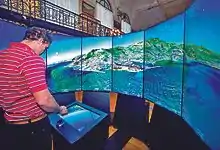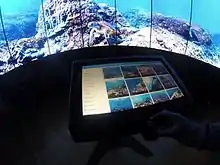
The Liquid Galaxy is an open source project founded by Google. Created in 2008 by Google employee Jason Holt, the Liquid Galaxy started out as a panoramic multi-display Google Earth viewer, but shifted to a general data visualization tool for various uses including operations, marketing, and research.[1]
The Liquid Galaxy enables users to navigate Google Earth, view videos and photos, develop interactive tours, and graphically display GIS data.[2]
Liquid Galaxies are regularly used by Google to showcase Google's geospatial technologies and to promote its image at trade shows and exhibits. Some companies, nonprofits (e.g. Sylvia Earle Alliance/Mission Blue[3]), and universities (e.g. Auburn University,[4] University of North Carolina at Chapel Hill,[5] and Westfield State University[6]) use Liquid Galaxies.

Development partners
For most of the life of Liquid Galaxy, Liquid Galaxy construction and support has been outsourced to End Point Corporation.[7] Other companies like Tietronix and GLGteam have also produced Liquid Galaxy systems.[8]
References
- ↑ Mellen, Mickey (29 April 2014). "Expanding the capabilities of the Liquid Galaxy". Google Earth Blog.
- ↑ "Liquid Galaxy". Google.
- ↑ "Liquid Galaxy at Sylvia Earle Alliance/Mission Blue". Sylvia Earle Alliance/Mission Blue. 10 September 2012.
- ↑ "Liquid Galaxy at Auburn University". Auburn University, Alabama.
- ↑ "Liquid Galaxy at UNC Chapel Hill". University of North Carolina at Chapel Hill.
- ↑ "Liquid Galaxy at Westfield State University". Westfield State University, Massachusetts.
- ↑ "Liquid Galaxy by End Point". End Point Liquid Galaxy.
- ↑ "WhereToBuy - liquid-galaxy". code.google.com. Archived from the original on 2015-04-19.